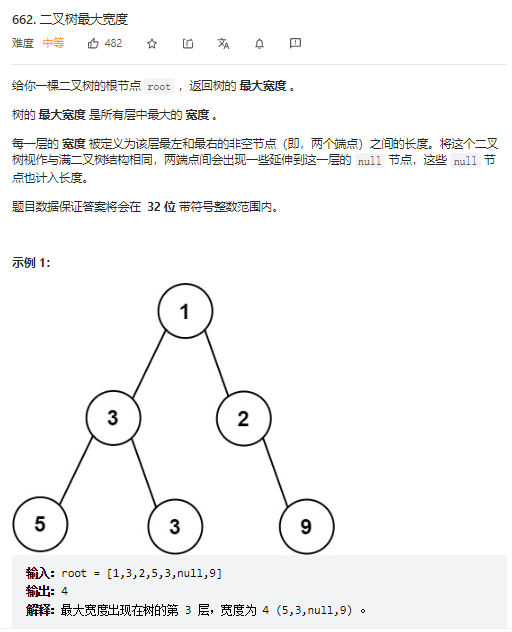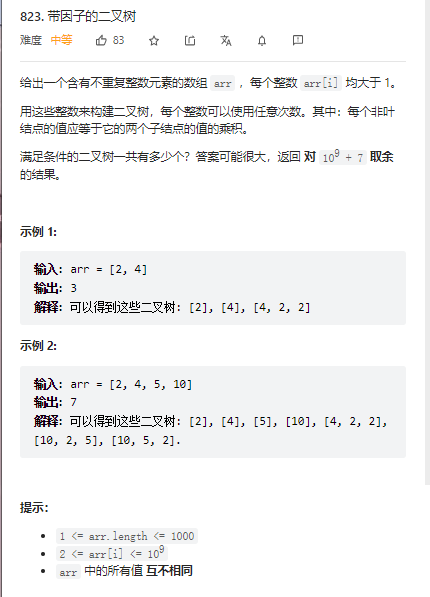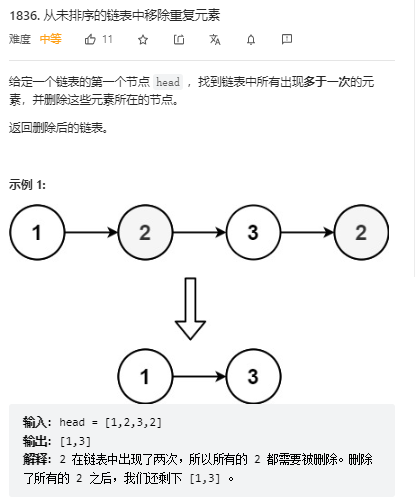[toc]
第一题:二叉树节点在某层是第几个的求解方法
662. 二叉树最大宽度 - 力扣(LeetCode)

注意是某一层最左边和最右边节点的距离,不包含右边的null
那么只要知道如果是完全二叉树的话, 他是这一层的第几个即可。
那就是父亲节点列索引乘2或者乘2+1
1
2
3
4
5
6
7
8
9
10
11
12
13
14
15
16
17
18
19
20
21
22
23
24
25
26
27
28
29
30
31
32
33
34
35
36
|
class Solution {
int res = 0;
public int widthOfBinaryTree(TreeNode root) {
dfs(root, 0, 0);
return res;
}
Map<Integer, Integer> minHIndex = new HashMap<>();
void dfs(TreeNode node, int index, int h) {
if (node == null) {
return;
}
if (!minHIndex.containsKey(h)) {
minHIndex.put(h, index);
}
res = Math.max(index - minHIndex.get(h) + 1, res);
dfs(node.left, index*2, h+1);
dfs(node.right, index*2+1, h+1);
}
}
|
第二题 基于树的简单动态规划
823. 带因子的二叉树 - 力扣(LeetCode)

排个序,然后按顺序求每个节点作为根节点的情况数,并放入缓存中
1
2
3
4
5
6
7
8
9
10
11
12
13
14
15
16
17
18
19
20
21
22
23
24
25
26
27
28
29
30
| class Solution {
public int numFactoredBinaryTrees(int[] arr) {
Arrays.sort(arr);
int mod = 1000000007;
Map<Integer, Long> map = new HashMap<>();
long res = 0;
for (int i = 0; i < arr.length;i++) {
int big = arr[i];
long count = 1;
for (int j = i-1;j>=0;j--) {
int numLeft = arr[j];
if (big % numLeft != 0) {
continue;
}
int numRight = big / numLeft;
if (!map.containsKey(numRight)) {
continue;
}
long count1 = map.get(numLeft);
long count2 = map.get(numRight);
count += count1 * count2;
count %= mod;
}
map.put(big, count);
res += count;
res %= mod;
}
return (int)res;
}
}
|
第三题 简单链表+哈希题
1836. 从未排序的链表中移除重复元素 - 力扣(LeetCode)

1
2
3
4
5
6
7
8
9
10
11
12
13
14
15
16
17
18
19
20
21
22
23
24
25
26
27
28
29
30
31
32
33
34
|
class Solution {
public ListNode deleteDuplicatesUnsorted(ListNode head) {
ListNode newHead = new ListNode(0);
newHead.next = head;
ListNode node = head;
Map<Integer, Integer> map = new HashMap<>();
while(node != null) {
map.put(node.val, map.getOrDefault(node.val, 0) + 1);
node = node.next;
}
ListNode lastNode = newHead;
node = head;
while(node != null) {
if (map.get(node.val) > 1) {
lastNode.next = node.next;
node = node.next;
} else {
lastNode = node;
node = node.next;
}
}
return newHead.next;
}
}
|





